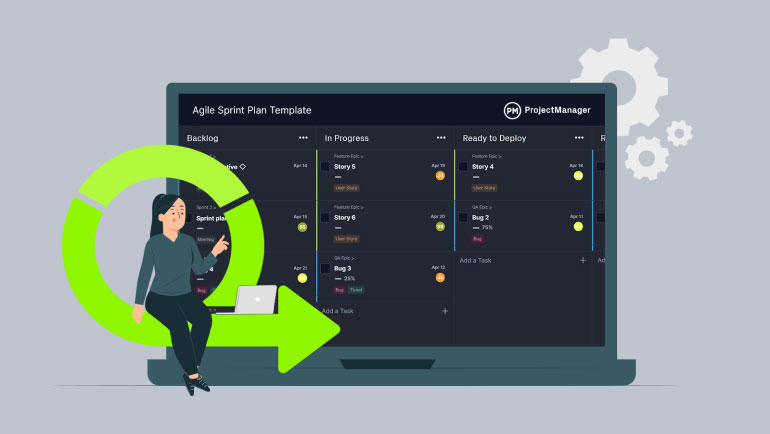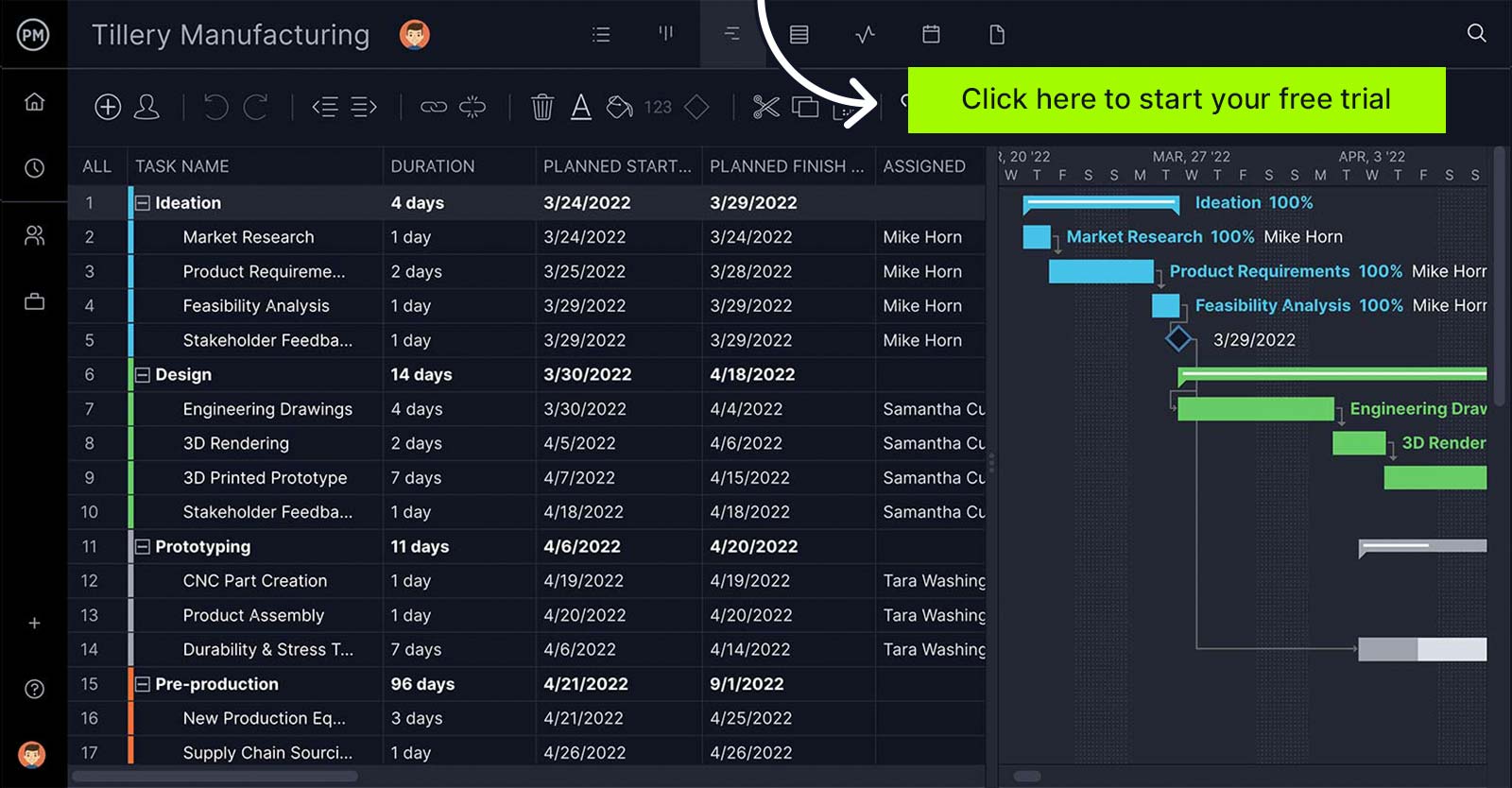All businesses must make money in order to remain solvent and stay in business. The need for profitability is clear—how you get there is the tricky part.
One way is to deliver more value to your customers while creating less waste for the business. This is commonly called lean project management.
What Is Lean Project Management?
Lean project management is just like traditional project management in that it follows a structured project life cycle, uses formal project management documentation, and aligns with core principles, procedures standards for project initiation, planning, execution, monitoring, and closure.
However, what sets it apart is the integration of Lean manufacturing principles and techniques to enhance efficiency and value delivery. Lean project management emphasizes the elimination of waste (muda), the continuous improvement mindset of Kaizen, and the use of tools like value stream mapping to visualize and streamline workflows.
It also adopts pull systems and just-in-time (JIT) practices to reduce excess inventory and unnecessary delays, ensuring work is pulled based on actual demand. By combining the discipline of project management with the agility and efficiency of lean thinking, this approach helps teams deliver projects faster, with fewer resources, and greater alignment to customer needs—all while maintaining full control over project scope, time, cost, and quality.
Lean manufacturing was developed by Toyota, which is why it uses Japanese words to refer to the elimination of waste in a manufacturing system (muda), waste created by overburden (muri) and waste that comes about because of uneven workloads (mura).
The lean manufacturing methodology has five lean principles, value, value stream, pull system, continuous flow and perfection. We’ll learn about those below.
Key Areas of Lean Project Management
Now, let’s define the key concepts and techniques from lean manufacturing that lean project management has adopted and how they can be used throughout the project life cycle.
- 5 Lean principles
- Lean waste types
- 5S Method
- Kaizen
- Pull system
- Just-in-time production
The 5 Lean Principles
These principles have been around for a while but were codified in 1997 by the Lean Enterprises Institute (LEI). When it comes to project management, the lean principles focus on defining what deliverables or requirements matter most to the project client and prioritizing all efforts and resources into achieving them, while eliminating unnecessary work.
- Value: Value is defined by your customer, client or stakeholder. Value can be the quality, timeline or price point of your deliverable—though it’s likely a bit of all three. Know what requirements you need, and what expectations to meet.
- Value Stream: You have defined value, now it’s time to map all the steps and processes in your manufacturing cycle. That sequence of steps is known as a value stream in lean project management. Identify every action that must take place in the project, including design, procurement, production, HR, admin and more. It’s helpful to draw this value stream map on one page to illustrate the flow of resources.
- Continuous Flow: There shouldn’t be any points that will create bottlenecks or interrupt production. According to LEI, “Make the value stream steps occur in tight sequence so that the product or service will have a continuous flow toward the customer.” It often requires cross-functional teams but results in greater productivity.
- Pull System: This is when the customer, client or stakeholder “pulls” the product or service from the project as needed. In other words, the improvements of the prior step lead to faster time-to-market. The advantage of the pull system is no warehousing or stockpiling. That saves money for the business that can then be passed on to their customers.
- Perfection: The final step is spreading the philosophy throughout the entirety of your business. Lean is about continuous improvement. Therefore, everyone in the business must always strive to better themselves and the processes they’re involved with. Often it takes several go-throughs to get to the value and really reduce the waste.
Lean Waste Types
Lean waste types refer to the seven categories of non-value-adding activities that hinder efficiency and productivity in a process. These include overproduction, waiting, transportation, overprocessing, inventory, motion and defects—collectively remembered by the acronym TIMWOOD. By identifying and eliminating these wastes, organizations can streamline workflows, reduce costs and improve customer satisfaction.
5S Method
The 5S method is a workplace organization technique that enhances efficiency and safety through five Japanese principles: seiri (sort), seiton (set in order), seiso (shine), seiketsu (standardize) and shitsuke (sustain). By implementing 5S, teams create clean, well-organized environments that support continuous improvement and make problems easier to detect and correct.
Kaizen (Continuous Improvement)
Kaizen is the lean principle of continuous, incremental improvement involving all employees. It focuses on small, daily changes that collectively lead to significant enhancements over time. Kaizen fosters a culture where feedback and innovation are encouraged, driving long-term growth and quality in processes, products, and services.
Just-in-Time Production
Just-in-Time (JIT) production is a Lean principle aimed at reducing inventory costs by producing only what is needed, when it is needed and in the exact quantity required. This approach minimizes waste, improves cash flow and enhances responsiveness to customer demand, but requires tight coordination with suppliers and accurate demand forecasting.
When to Implement Lean Project Management?
Lean project management is best implemented when organizations aim to improve efficiency, reduce waste and maximize customer value. Whether you’re launching a new product, managing a complex build, or streamlining operations, Lean principles can help drive better results with fewer resources. It’s especially useful in industries where timelines, budgets and quality are tightly interlinked.
Manufacturing
Lean project management originated in manufacturing, making it a natural fit for this industry. By focusing on eliminating waste (like excess inventory or idle time) and optimizing production flow, manufacturers can boost productivity, reduce costs and deliver higher quality products with fewer defects.
Construction
In construction, lean project management helps minimize delays, reduce material waste and improve coordination across teams. Lean methods encourage just-in-time delivery, standardized work processes and continuous feedback, all of which contribute to more predictable project timelines and lower overall costs.
Product and Software Development
Lean is highly effective in product and software development, where agility and responsiveness are key. By applying Lean principles such as continuous improvement and customer-focused design, development teams can reduce cycle times, prioritize high-value features and release better products faster while staying aligned with stakeholder needs.
The Definition of a Lean Project
Lean was developed in manufacturing, but the lean principles have spread to many different industries such as project management and construction. A lean project is simply one in which there is continuous improvement.
That makes it part of the larger agile project management environment, in that it’s flexible and willing to change as needed. It’s all about delivering value to the customers and stakeholders, which is the same whether you’re manufacturing a car or an app.
One of the aspects of lean that makes it unique from traditional project management methodologies is that it applies the five principles of lean project management. That’s the first step in a lean project: identifying the five lean principles, then applying them to your project.

Get your free
Agile Sprint Plan Template
Use this free Agile Sprint Plan Template to manage your projects better.
Get the Template
What Are the Benefits of Lean Project Management?
When the Toyota Production System (TPS) was first introduced, it allowed the car company to improve value for its customers. The proof is in the pudding; the (then) small car manufacturer has become one of the largest automakers in the world. While the term lean manufacturing didn’t appear until the 1990s, the benefits of lean project management were evident. Here are some:
- Greater visibility into the manufacturing process
- More control, better decision-making and empowers teams
- Boosts productivity and morale
- Provides alternative ways to get deliverables out the door
- Faster projects due to having to respond to fewer issues
- Boosts profits, as more value is added and waste is reduced
- Increased customer satisfaction
As companies reap these benefits, they have more funds to invest in workers, tools and equipment. This creates a snowball effect of creating even more value and reducing even more waste from the production system. It’s a win-win situation in the best business sense.
To reap all these benefits, you need project management software that provides visibility and connection. ProjectManager is cloud-based software that shares data across multiple project views. For example, the list view can tag tasks, add priority and display the current task status. Try ProjectManager today for free.

What About Lean Program Management?
Projects don’t occur neatly, one after another. More likely, project managers are responsible for overseeing a number of projects. A portfolio is a lot of projects, but a program is a lot of related projects. These can benefit from a lean approach, too.
You can use the five lean principles when managing a program. By looking at all your projects through the lens of lean program management, you find areas where there is waste among the projects. Then, you can pinpoint the value and share resources to help all the projects flow better together.
While it’s not as well-known as lean project management, lean program management is just another example of the fifth lean principle of perfection. If lean principles help a project, they will help a program. Continuous improvement means expanding the reach of your lean approach and having it inform all aspects of your business.
How ProjectManager Helps With Lean Project Management
Mapping your value stream on paper is a good start, but project management software can help you find and eliminate waste. ProjectManager is cloud-based software that connects teams and delivers real-time data for better decision-making.
Create Start-to-Finish Project Plans
Finding value and removing waste requires that you see the entire project in one place. View all the tasks and determine which are keepers and which are unnecessary. ProjectManager’s online Gantt chart lets you map the project and identify task dependencies that can cause bottlenecks. There’s also a filter to chart the critical path, which allows you to see the most efficient way to execute the project and avoid those steps that aren’t adding value.

Create Flexible Workflows on Kanban Boards
Transparency is key to lean project management. Dynamic kanban boards allow project managers a window into the production cycle without getting in the way of their teams. Meanwhile, teams can manage their backlog of tasks and plan how to execute their work. They can comment on tasks and get notifications by email or in the app when there is a response or update to the work.

Balance Your Team’s Workload On-the-Fly
Balancing workload is also bedrock to lean project management. Our resource management features let you see your team’s assignments in a color-coded chart that shows who has too many or too few assignments. Then, you can re-allocate right from the workload chart to keep your team working at capacity.

Ensure Efficiency is Met with Dashboards
Teams can work how they want with our multiple project views, project managers can get data on their progress with one-click reports and a high-level view from the real-time dashboard. There are even lean program management reports and tools, such as the roadmap, which shows all the projects in your program in one place. You need a flexible tool such as ProjectManager to run a lean project.

Related Content
- What Is Lean Construction?
- What Is Lean Manufacturing?
- What Is Lean Portfolio Management? A Quick Guide
- The 5 Lean Principles: Definitions & How to Use Them
ProjectManager is award-winning software that organizes tasks, teams and projects to boost productivity and streamline your processes. The tool is designed to add value and reduce waste, just as lean project management mandates. Join the tens of thousands of teams at businesses as varied as the Bank of America to Ralph Lauren who use our tool to work better together. Try ProjectManager for free today.

